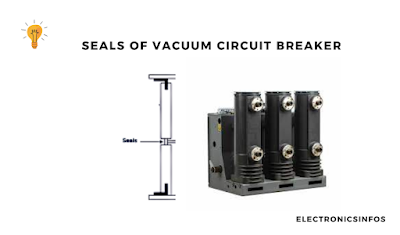What is a Vacuum Circuit breaker(VCB)?
A vacuum circuit breaker is a type of circuit breaker in which a vacuum is used as an insulating medium. The vacuum circuit breaker is used up to 28 kV for ideal circuits.
There are two contacts in the vacuum circuit breaker one is fixed contact and another one is variable contact which exists in the insulating envelope.
The main part of the Vacuum circuit breaker is the vacuum interrupter. The air pressure in the interrupter is 10-⁷ mm of Hg which is the highest vacuum.
We also used multi-unit VCB for up to 72kv. Multi-interrupter circuits are widely used in America, Japan and other countries.
There are many properties of vacuum circuit breakers including
Properties of Vacuum Circuit Breaker(VCB)
- High insulating Strength
- fast operation
- Recovery of dielectric strength
- suitable for repeated work
- simple operating mechanism
- flexible design
- low weight
- low distance between contacts
- long life
- less maintenance required
Construction of Vacuum Circuit Breaker(VCB)
Parts Of the Vacuum Circuit Breaker(VCB)
- Upper Support and heatsink
- Terminal of pole
- Insulator support rod
- Fixed contact Piece
- Moving contact piece
- insulator
- Metallic bellows
- Lower terminal
- Lower heat sink
- Mechanism Linkage
- Glass fibre rod
- opening spring
The parts of a vacuum interrupter including
Parts Of Vacuum Interrupter
- electrodes (Fixed and moving)
- Metallic bellows
- Vapour condensing Shield
- Seals
- Insulating envelope
- End shields
- Fixed contact stem
- Moving contact stem
- Shield support flange
- Vacuum
Metallic Bellows
The metallic bellows are made of the material Stainless steel. One part of the bellows is connected with a metal flange and another one is connected with moving contact.
Vapour condensing Shields
The metal shields are used to avoid the arching effect in insulating enclosures. These shields are surrounded by the contact region.
Seals
Seals are used to maintain the vacuum in the circuit breaker for a long time. these seals are made with metal glass or metal-ceramic cells.
The insulating envelope is used to tolerate the mechanical pressure. The glass material is used as an insulating Envelope.
End Shields
The End shields are non-magnetic materials that support the End flange, enclosure, fixed contact, vapour condensing shields, bellows etc.
Contact Stem
The back part of Contact faces is called the contact stem. This is made with a high-conducting material. the melting point of contact is high.
Properties of Electrodes
There are some properties of Electrodes including
- The Electrodes must have good electrical conductivity.
- The Electrodes must have good thermal conductivity to discharge the heat.
- It must have a high cold and hot hardness to avoid wear and tear.
- The electrodes must have a high-density
- Electrodes must have a high thermionic function.
- High boiling and melting point.
- The contact resistance must be low.
- The process of manufacturing is easy and economical.
There are many materials used for the manufacturing of electrodes including copper bismuth alloy, copper chromium alloy, copper-beryllium alloy etc
Types Of Vacuum Interrupters
There are two types of vacuum interrupters including
- Single Unit Per pole Interrupter
- Multi unit per pole interrupter
Mechanism of VCB
when current-carrying Contacts are separate in the VCB The arc is produced. In this circuit breaker, the Extinguish mechanism is different compared to other circuit breakers. In this circuit breaker, the vacuum is used as a dielectric medium.
when contacts are separated, the gas is ionized and some contact materials provide the charged particles due to the field's emission. As a result, the arc plasma state is created depending on the arc current.
when the current wave is low the discharge value of vapours is also low. when the current is zero the medium retains the actual value and provides better dielectric strength.
The most important thing in the VCB is the fast Recovery of dielectric strength. In the VCB The Arc distinction depends on the following things
- The Vacuum degree in the interrupter
- The Effectiveness of Operating Mechanism
- The peak value of Arc's current
- The changing ratio of Arc's current
- The emission of energy
- Arc plasma
- The peak value of TRV (Transient Recovery voltage)
Advantages of vacuum circuit breaker (VCB)
- fast recovery of dielectric Strength
- The low weight of Moving parts
- The efficiency is higher
- free from pollution because of no gas decomposition.
- No need for oil and gas.
- No chance of Explosion in the VCB.
- The lifetime is high
- Fast operation
- Need less maintenance
- The contact resistance is not changed during the working of VCB.
Disadvantages of vacuum circuit breaker(VCB)
- The Vacuum interrupter is Expensive compared to other interrupters.
- The single interrupter is limited to up to 20KV. if we connect in series to obtain high value the cost is high.
- High technology is needed to manufacture the Vacuum interrupter.
- if the breaker fails the vacuum is also lost so no repair model.







.png)



0 Comments
please do not insert spam links